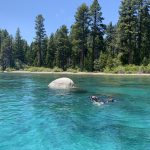Rare seabird lands in Tahoe, draws birders from near and far
SOUTH LAKE TAHOE, Calif. – What started as an inquiring Facebook post to identify a bird turned into a birder’s dream discovery. The mystery bird was identified as a Cocos booby, which are rarely seen outside of the ocean.
First spotted on Aug. 1, a Tahoe resident posted to the Tahoe Birding Facebook Page, asking “Saw him flying at Keys Beach today, any idea what kind he is?”
Sarah Hockensmith, Tahoe Institute for Natural Science (TINS) Outreach Director, immediately recognized the bird as a booby.

“It is a bit insane for a booby to show up at Lake Tahoe,” Will Richardson said, TINS Executive Director. “It’s a tropical seabird that lives on the ocean, and this species, up until 25-30 years ago, was still pretty rare to see anywhere in the state of California.”
The rare occurrence triggered what’s been called a “birding frenzy” or “birding pilgrimage,” drawing birders from near and far, including a couple from Minnesota, to catch a glimpse.
“For whatever reason, this booby decided to fly up and over the Sierra Nevada. It’s just mind-boggling,” Richardson said, explaining that this is how range expansions happen and it’s ultimately a good sign of adaptation.
TINS says that climate change, warming ocean currents, and redistributions of prey base led to numerous Brown/Cocos booby sightings along the coast of Southern California in the early 2000s. Then, in November 2017, biologists at Channel Islands National Park documented 102 boobies and four nests on a rocky islet near Santa Barbara Island.
“That’s huge to go from super rare to nesting in colonies in a period of 10-15 years,” Richardson said. “And they continue to expand their range and become more numerous.”
Although boobies and other birds can get blown well out of their typical habitats during big storms, the bird’s appearance in South Lake Tahoe was slightly baffling because weather patterns were clear.
The bird’s eventual demise
Observations revealed the bird was feeding well, displaying acrobatics and cartwheeling dives as it fed on small baitfish. However, TINS explains, it was up against formidable dietary challenges.

Evolved to process large amounts of salt, the seabird was missing the salinity in the fresh-water prey. It’s believed this is what led to its demise after it was found dead on a boat at Ski Run Marina on Aug. 9.
Just that morning, it was seen fishing and the night before, took a long, high flight west at sunset.
“It’s sad when birds end up in a place where they can’t live, but overall,” Richardson said, “it’s a sign of nature’s perseverance.”
Staff at the marina were holding the specimen for TINS, but it was taken by an unauthorized party and has disappeared, jeopardizing further studies of the bird.
“With a tissue sample, we would be able to determine its species definitively, which would be very useful to be able to know the distribution patterns of these birds as they expand,” Richardson said, explaining it was a juvenile bird that may have flown from the Gulf of Mexico, making it a Brown Booby. “If we had the specimen, we also would be able to determine its stomach contents and perhaps confirm how and why it died.”
The frenzy underscores the importance of citizen science
TINS says, despite its demise, the booby sparked widespread documentation and discussion, highlighting the importance of citizen science.
“One curious post on a Facebook group can lead to great discoveries,” Richardson pointed out, encouraging everyone to use the camera on their phone and post their photos. “You never know what discovery you might make.”
He says these wildlife observations can become important data that allows scientists to track range, expansion, changes, contractions and even declines in populations over time, leading to policy changes.
The event highlights Lake Tahoe’s existence as a place that harbors a diverse index of birds, even if for just a short time. TINS reports over 320 species documented in the Lake Tahoe Basin, including:
- Scissor-tailed Flycatcher, the state bird of Oklahoma
- A Western Sandpiper that was color-banded in Siberia
- Lesser Black-backed Gulls, likely breeding in Iceland
- Arctic Terns that are flying almost from pole to pole
- Other ocean-migrating species like jaegers and Sabine’s Gulls
“We are truly connected to most of the Western Hemisphere and then some with the birds that come through the Lake Tahoe area,” Richardson said.

Support Local Journalism

Support Local Journalism
Readers around the Lake Tahoe Basin and beyond make the Tahoe Tribune's work possible. Your financial contribution supports our efforts to deliver quality, locally relevant journalism.
Now more than ever, your support is critical to help us keep our community informed about the evolving coronavirus pandemic and the impact it is having locally. Every contribution, however large or small, will make a difference.
Your donation will help us continue to cover COVID-19 and our other vital local news.











